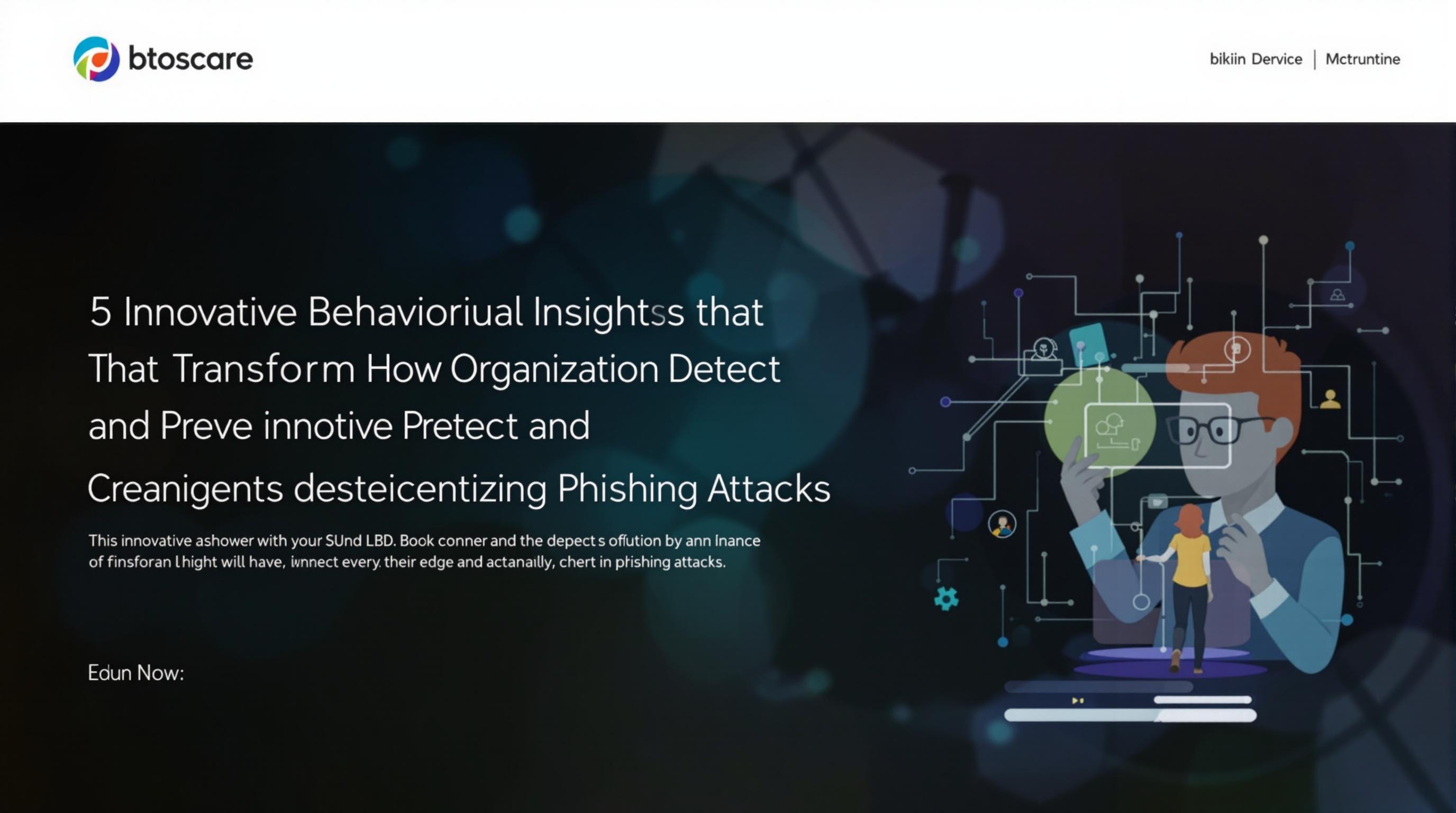Related Articles
- Unveiling the Silent Effects of Malware Residue on IoT Devices and What It Means for Your Connected Home Security
- Top 6 Game-Changing Email Security Suites Released Since 2019 That Actually Stop Cyber Trickery
- The Hidden Impact of AI-Driven Voice Assistants on Your Device’s Safety: Risks Nobody Talks About
- Top 6 Stealth Encryption Products Redefining Data Privacy You Haven’t Heard About Since 2019
- Exploring the Influence of Wi-Fi Radiation on Human Sleep Patterns and Cognitive Health in Modern Living
- Top 8 Stealth Malware Cleaners from the Past 5 Years That Outsmart Evasive Threats
5 Innovative Behavioral Insights That Transform How Organizations Detect and Prevent Phishing Attacks
5 Innovative Behavioral Insights That Transform How Organizations Detect and Prevent Phishing Attacks
5 Innovative Behavioral Insights That Transform How Organizations Detect and Prevent Phishing Attacks
Introduction to Behavioral Insights in Phishing Defense
Phishing remains one of the most pervasive cyber threats impacting organizations globally. Traditional technical defenses, such as firewalls and antivirus solutions, while necessary, often fall short in fully preventing phishing attacks. This gap has led cybersecurity experts to explore behavioral insights—understanding how human behavior influences susceptibility to phishing. Incorporating these insights into cybersecurity strategies can significantly enhance detection and prevention efforts.
Behavioral science focuses on how individuals perceive, interpret, and respond to phishing attempts. By analyzing patterns in how employees engage with suspicious emails, organizations can tailor their defenses to counteract common psychological vulnerabilities. For instance, exploiting fear, urgency, or curiosity are tactics frequently used by attackers to elicit quick, unthinking responses.
Integrating behavioral insights shifts the focus from solely technological solutions to a more comprehensive approach involving human factors. This method emphasizes awareness, training, and detection mechanisms that align with actual user behavior, leading to more effective mitigation of phishing risks across organizational environments.
Insight 1: Understanding Cognitive Load and Its Impact on Phishing Susceptibility
Cognitive load refers to the amount of mental effort being used in working memory. When employees face high cognitive load, such as dealing with multiple tasks simultaneously, their ability to thoroughly scrutinize emails diminishes. Attackers exploit these moments, aiming phishing attempts at times of distraction or stress.
Organizations can leverage this insight by adjusting workflows to reduce cognitive overload, especially during critical communication periods. For example, limiting the number of simultaneous urgent requests or providing clear prioritization can help employees maintain vigilance over suspicious messages.
Additionally, phishing awareness training that includes strategies to recognize cognitive overload and techniques to pause and evaluate suspicious emails can reinforce user resilience. Such behavioral adaptations have been shown to reduce click rates on phishing links significantly (Hadnagy, 2018).
Insight 2: Leveraging Social Norms to Encourage Secure Email Practices
Social norms—shared expectations about behaviors within a group—play a crucial role in influencing individual actions. When secure email practices are perceived as standard and positively reinforced, employees are more likely to adopt them naturally.
Organizations can promote social norms by celebrating successful phishing identification instances and promoting stories of employee vigilance. Peer support groups and gamified phishing simulations that provide public recognition help create a culture where security awareness is the norm.
Research indicates that interventions emphasizing social proof, where individuals see others practicing secure behaviors, increase compliance rates and reduce risky actions (Wright et al., 2020). This approach turns the collective power of employee behavior into a frontline defense.
Insight 3: Utilizing Emotional Triggers to Enhance Phishing Detection
Phishing emails frequently use emotional triggers such as fear, excitement, or urgency to prompt immediate action without careful thought. Understanding these triggers allows organizations to develop tailored warning messages and training that help employees recognize and resist emotionally manipulative content.
For instance, simulated phishing attempts that replicate emotional appeals can teach employees to recognize and pause before reacting. Incorporating emotional intelligence components into cybersecurity education empowers employees to manage their reactions actively.
Behavioral research has shown that training programs focusing on emotional regulation skills can reduce susceptibility to phishing, as employees become better equipped to analyze messages critically regardless of the emotional content (Jia et al., 2019).
Insight 4: Behavioral Biometrics and Anomaly Detection
Beyond training, organizations increasingly adopt behavioral biometrics, analyzing unique user interaction patterns such as typing rhythm, mouse movement, and navigation habits. These patterns can reveal anomalies indicative of phishing or compromised accounts.
By continuously monitoring behavioral data, security systems can detect deviations from normal user behavior quickly and flag potential threats. This approach complements traditional security measures by focusing on the behavior of the user rather than only technical indicators.
Studies demonstrate that integrating behavioral biometrics improves early detection accuracy and reduces false positives in phishing detection systems (Ahmed et al., 2016). As attackers attempt to mimic legitimate user activity, behavioral biometrics provide an additional, harder to spoof layer of defense.
Insight 5: Applying Habit Formation Techniques to Reinforce Security Practices
Habit formation strategies involve designing cues and routines that encourage positive security behaviors until they become automatic. Developing habitual email security checks, such as verifying sender details or avoiding clicking unknown links, reduces the cognitive effort required for vigilance.
Organizations can facilitate habit formation by using reminders, consistent training schedules, and leveraging technology prompts like phishing alerts or autofill warnings. Reinforcing these habits regularly helps employees internalize security practices in their daily workflow.
Research from behavioral psychology suggests that habits formed through repeated action and reinforcement persist longer and require less conscious effort, creating sustainable changes in cybersecurity culture (Lally et al., 2010).
Integrating Behavioral Insights into Organizational Policies
To maximize effectiveness, behavioral insights must be integrated into official security policies and organizational culture. Policies should reflect an understanding of employee behavior patterns and encourage proactive engagement with security protocols.
This could include embedding behavioral indicators into incident response frameworks, ensuring that policy compliance is monitored not only by technical means but also by assessing user interactions and responses. Leadership buy-in is essential to enforce and promote these behavioral approaches consistently.
Embedding these insights into policies supports a holistic security posture, where human factors are treated as a strategic advantage, reducing the likelihood and impact of phishing attacks across the organization.
The Role of Continuous Training and Feedback Loops
Behavioral change requires ongoing reinforcement. Continuous training programs that adapt to emerging phishing tactics and evolving behavioral patterns ensure that employees remain vigilant. Feedback loops, such as immediate alerts after simulated phishing tests, help users learn from their mistakes promptly.
Dynamic training and feedback enhance user engagement, transforming passive recipients of instructions into active participants in security. They also foster a growth mindset where learning from errors strengthens overall defense mechanisms.
According to cybersecurity education research, continuous, context-relevant training significantly improves phishing detection rates compared to one-time sessions (Sawyer et al., 2021). Feedback accelerates learning and sustains behavioral changes.
Measuring Behavioral Impact on Phishing Defense Effectiveness
Quantifying the impact of behavioral insights is critical for refining strategies and demonstrating their value. Metrics such as click-through rates on simulated phishing emails, incident reports, and user engagement levels provide tangible indicators of behavioral change.
Advanced analytics can correlate behavior data with security incidents, revealing which behavioral interventions yield the greatest reduction in phishing success. Organizations can then allocate training resources effectively and prioritize initiatives with measurable returns.
Ongoing assessment creates a feedback-driven improvement cycle, ensuring that behavioral strategies keep pace with threat evolution and organizational dynamics, maintaining robust phishing defenses.
Future Directions: AI and Behavioral Psychology in Phishing Prevention
Emerging technologies like artificial intelligence (AI) are increasingly integrated with behavioral psychology to innovate phishing defenses. AI systems analyze vast behavioral datasets to predict phishing susceptibility and tailor interventions in real time.
Personalized phishing simulations, adaptive training modules, and AI-driven anomaly detection are examples of sophisticated tools that blend behavioral insights with machine learning. This synergy enhances detection precision and user-specific prevention tactics.
As research progresses, the collaboration between cybersecurity experts and behavioral scientists will deepen, creating proactive, intelligent defenses that anticipate human factors and attacker strategies, fostering safer organizational environments.
Conclusion: Embracing Behavioral Insights for Comprehensive Phishing Defense
Phishing attacks exploit human vulnerabilities as much as technical gaps. Incorporating innovative behavioral insights transforms organizational approaches from reactive defenses to proactive, human-centered strategies. By understanding cognitive load, social norms, emotional triggers, behavioral biometrics, and habit formation, organizations can build resilient security cultures.
These insights complement existing technologies and policies, creating multi-layered defenses that reduce phishing risks significantly. Continuous training, measurement, and leveraging AI will further enhance these behavioral strategies, making phishing prevention more adaptive and effective.
Ultimately, the future of phishing defense lies in the fusion of technology and behavioral science, empowering employees as active defenders and creating safer digital workplaces for all.
References:
Ahmed, M., Mahmood, A. N., & Hu, J. (2016). A survey of network anomaly detection techniques. Journal of Network and Computer Applications.
Hadnagy, C. (2018). Social Engineering: The Science of Human Hacking. Wiley.
Jia, Y., Wang, D., & Xu, F. (2019). The impact of emotional intelligence on phishing detection performance: A behavioral analysis. Cyberpsychology, Behavior, and Social Networking.
Lally, P., van Jaarsveld, C. H. M., Potts, H. W. W., & Wardle, J. (2010). How are habits formed: Modelling habit formation in the real world. European Journal of Social Psychology.
Sawyer, B., Bashir, M., & Fiela, A. (2021). Effectiveness of continuous cybersecurity training on phishing prevention behavior. Computers & Security.
Wright, R. T., Marett, K., & Lee, M. (2020). The influence of social norms on phishing susceptibility. Journal of Computer Information Systems.




